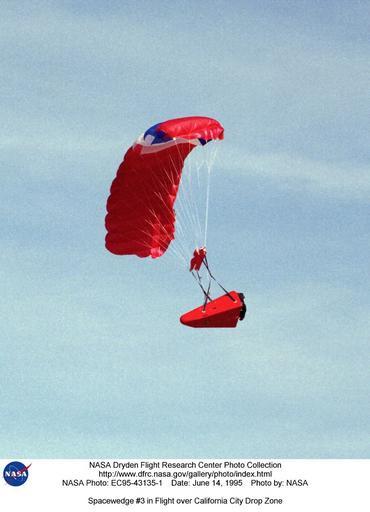MAKE A MEME
View Large Image

| View Original: | Spacewedge_-3_in_Flight_over_California_City_Drop_Zone_DVIDS697086.jpg (1109x1536) | |||
| Download: | Original | Medium | Small | Thumb |
| Courtesy of: | commons.wikimedia.org | More Like This | ||
| Keywords: Spacewedge -3 in Flight over California City Drop Zone DVIDS697086.jpg en One of the Spacewedge remotely-piloted research vehicles in flight under a steerable parafoil during 1995 research flights conducted by NASA's Dryden Flight Research Center From October 1991 to December 1996 NASA Ames-Dryden Flight Research Facility after 1994 the Dryden Flight Research Center Edwards California conducted a research program know as the Spacecraft Autoland Project This Project was designed to determine the feasibility of the autonomous recovery of a spacecraft using a ram-air parafoil system for the final stages of flight including a precision landing The Johnson Space Center and the U S Army participated in various phases of the program The Charles Stark Draper Laboratory developed the software for Wedge 3 under contract to the Army Four generic spacecraft each called a Spacewedge or simply a Wedge were built; the last one was built to test the feasibility of a parafoil for delivering Army cargoes Technology developed during this program has applications for future spacecraft recovery systems such as the X-38 Crew Return Vehicle demonstrator The Spacewedge program demonstrated precision flare and landing into the wind at a predetermined location The program showed that a flexible deployable system using autonomous navigation and landing was a viable and practical way to recover spacecraft NASA researchers conducted flight tests of the Spacewedge at three sites near Dryden a hillside near Tehachapi the Rogers Dry Lakebed at Edwards Air Force Base and the California City Airport Drop Zone During the first phase of testing 36 flights were made Phase II consisted of 45 flights using a smaller parafoil A third Phase of 34 flights was conducted primarily by the Army and resulted in the development of an Army guidance system for precision offset cargo delivery The wedge used during the Army phase was not called a Spacewedge but simply a Wedge The Spacewedge was a flattened biconical airframe joined to a ram-air parafoil with a custom harness In the manual control mode the vehicle was flown using a radio uplink In its autonomous mode it was controlled using a small computer that received input from onboard sensors Selected sensor data was recorded onto several onboard data loggers Two Spacewedge shapes were used for four airframes representing generic hypersonic vehicle configurations Spacewedge vehicles were 48 inches long 30 inches wide and 21 inches high Their basic weight was 120 pounds although different configurations weighed from 127 to 184 pounds Potential uses for Spacewedge-based technology include deployable precision autonomous landing systems such as the one deployed by the X-38 crew return vehicle; planetary probes; booster recovery systems; autonomous gliding parachute systems on military aircraft ejection seats; offset delivery of military cargoes; and delivery of humanitarian aid to hard-to-reach locations Dryden employees involved with the Spacewedge program included R Dale Reed who originated the concept of conducting a subscale flight test at Dryden and participated in the actual testing Alexander Sim managed the flight project and participated in its documentation James Murray served as the principal Dryden investigator and as the lead for all systems integration for Phases I and II the Spacewedge phases NASA Identifier NIX-EC95-43135-1 2009-09-23 Glenn Research Center https //www dvidshub net/image/697086 697086 2012-10-10 13 53 WASHINGTON DC US PD-USGov Edwards Air Force Base Images from DoD uploaded by Fæ | ||||